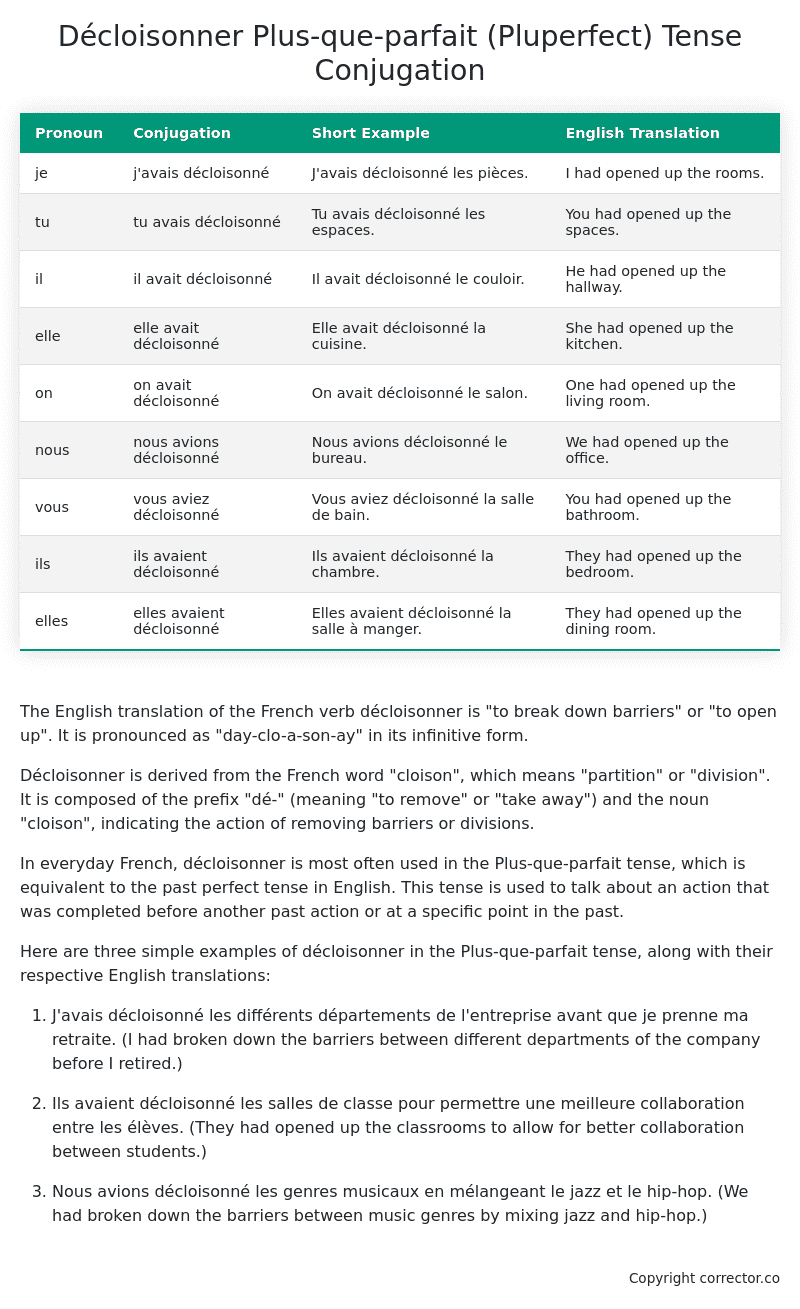Plus-que-parfait (Pluperfect) Tense Conjugation of the French Verb décloisonner
Introduction to the verb décloisonner
The English translation of the French verb décloisonner is “to break down barriers” or “to open up”. It is pronounced as “day-clo-a-son-ay” in its infinitive form.
Décloisonner is derived from the French word “cloison”, which means “partition” or “division”. It is composed of the prefix “dé-” (meaning “to remove” or “take away”) and the noun “cloison”, indicating the action of removing barriers or divisions.
In everyday French, décloisonner is most often used in the Plus-que-parfait tense, which is equivalent to the past perfect tense in English. This tense is used to talk about an action that was completed before another past action or at a specific point in the past.
Here are three simple examples of décloisonner in the Plus-que-parfait tense, along with their respective English translations:
-
J’avais décloisonné les différents départements de l’entreprise avant que je prenne ma retraite. (I had broken down the barriers between different departments of the company before I retired.)
-
Ils avaient décloisonné les salles de classe pour permettre une meilleure collaboration entre les élèves. (They had opened up the classrooms to allow for better collaboration between students.)
-
Nous avions décloisonné les genres musicaux en mélangeant le jazz et le hip-hop. (We had broken down the barriers between music genres by mixing jazz and hip-hop.)
Table of the Plus-que-parfait (Pluperfect) Tense Conjugation of décloisonner
| Pronoun | Conjugation | Short Example | English Translation |
|---|---|---|---|
| je | j’avais décloisonné | J’avais décloisonné les pièces. | I had opened up the rooms. |
| tu | tu avais décloisonné | Tu avais décloisonné les espaces. | You had opened up the spaces. |
| il | il avait décloisonné | Il avait décloisonné le couloir. | He had opened up the hallway. |
| elle | elle avait décloisonné | Elle avait décloisonné la cuisine. | She had opened up the kitchen. |
| on | on avait décloisonné | On avait décloisonné le salon. | One had opened up the living room. |
| nous | nous avions décloisonné | Nous avions décloisonné le bureau. | We had opened up the office. |
| vous | vous aviez décloisonné | Vous aviez décloisonné la salle de bain. | You had opened up the bathroom. |
| ils | ils avaient décloisonné | Ils avaient décloisonné la chambre. | They had opened up the bedroom. |
| elles | elles avaient décloisonné | Elles avaient décloisonné la salle à manger. | They had opened up the dining room. |
Other Conjugations for Décloisonner.
Le Present (Present Tense) Conjugation of the French Verb décloisonner
Imparfait (Imperfect) Tense Conjugation of the French Verb décloisonner
Passé Simple (Simple Past) Tense Conjugation of the French Verb décloisonner
Passé Composé (Present Perfect) Tense Conjugation of the French Verb décloisonner
Futur Simple (Simple Future) Tense Conjugation of the French Verb décloisonner
Futur Proche (Near Future) Tense Conjugation of the French Verb décloisonner
Plus-que-parfait (Pluperfect) Tense Conjugation of the French Verb décloisonner (this article)
Passé Antérieur (Past Anterior) Tense Conjugation of the French Verb décloisonner
Futur Antérieur (Future Anterior) Tense Conjugation of the French Verb décloisonner
Subjonctif Présent (Subjunctive Present) Tense Conjugation of the French Verb décloisonner
Subjonctif Passé (Subjunctive Past) Tense Conjugation of the French Verb décloisonner
Subjonctif Imparfait (Subjunctive Imperfect) Tense Conjugation of the French Verb décloisonner
Conditionnel Présent (Conditional Present) Tense Conjugation of the French Verb décloisonner
Conditionnel Passé (Conditional Past) Tense Conjugation of the French Verb décloisonner
L’impératif Présent (Imperative Present) Tense Conjugation of the French Verb décloisonner
L’infinitif Présent (Infinitive Present) Tense Conjugation of the French Verb décloisonner
Struggling with French verbs or the language in general? Why not use our free French Grammar Checker – no registration required!
Get a FREE Download Study Sheet of this Conjugation 🔥
Simply right click the image below, click “save image” and get your free reference for the décloisonner Plus-que-parfait tense conjugation!

Décloisonner – About the French Plus-que-parfait (Pluperfect) Tense
Tense Formation
Common everyday usage patterns
Sequencing of past events
Background information
Hypothetical or reported speech
Interactions with other tenses
Summary
I hope you enjoyed this article on the verb décloisonner. Still in a learning mood? Check out another TOTALLY random French verb conjugation!


